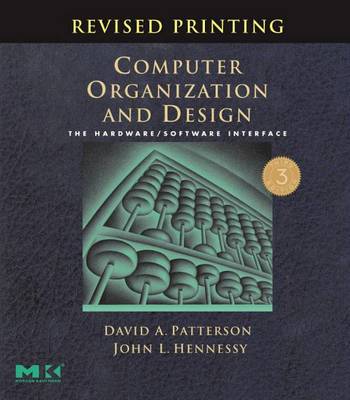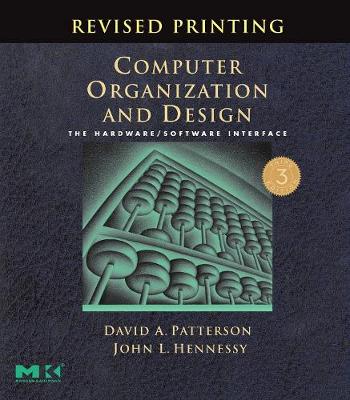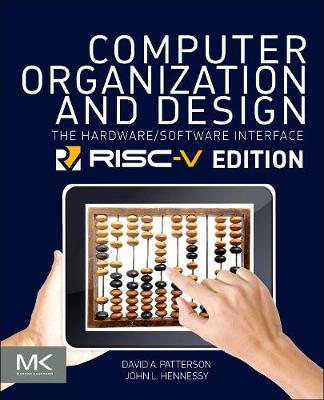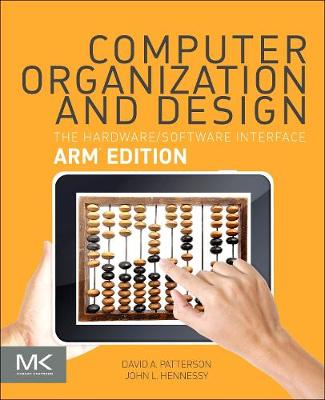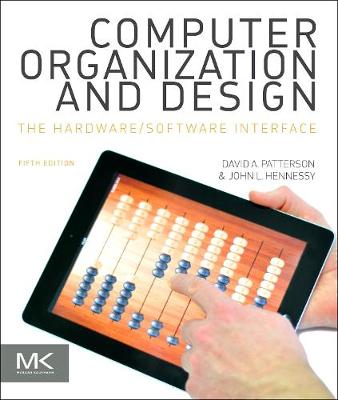The Morgan Kaufmann Series in Computer Architecture and Design
6 total works
This is a revision of an introduction to the field for all computer scientists and engineers. It includes improved examples of current architectures and updated pipelining and memory chapters to address modern processors.
Computer Architecture: A Quantitative Approach focuses on computer architecture as a modern science. The second edition explores the next generation of architectures and design techniques with view to the future. A basis for modern computer architecture.
Computer Organization and Design, Revised Printing, Third Edition
by David A. Patterson and John L. Hennessy
Published 27 July 2007
What’s New in the Third Edition, Revised Printing
The same great book gets better! This revised printing features all of the original content along with these additional features:
• Appendix A (Assemblers, Linkers, and the SPIM Simulator) has been moved from the CD-ROM into the printed book
• Corrections and bug fixes
Third Edition features
New pedagogical features
• Understanding Program Performance
- Analyzes key performance issues from the programmer’s perspective
• Check Yourself Questions
- Helps students assess their understanding of key points of a section
• Computers In the Real World
- Illustrates the diversity of applications of computing technology beyond traditional desktop and servers
• For More Practice
- Provides students with additional problems they can tackle
• In More Depth
- Presents new information and challenging exercises for the advanced student
New reference features
• Highlighted glossary terms and definitions appear on the book page, as bold-faced entries in the index, and as a separate and searchable reference on the CD.
• A complete index of the material in the book and on the CD appears in the printed index and the CD includes a fully searchable version of the same index.
• Historical Perspectives and Further Readings have been updated and expanded to include the history of software R&D.
• CD-Library provides materials collected from the web which directly support the text.
In addition to thoroughly updating every aspect of the text to reflect the most current computing technology, the third edition
• Uses standard 32-bit MIPS 32 as the primary teaching ISA.
• Presents the assembler-to-HLL translations in both C and Java.
• Highlights the latest developments in architecture in Real Stuff sections:
- Intel IA-32
- Power PC 604
- Google’s PC cluster
- Pentium P4
- SPEC CPU2000 benchmark suite for processors
- SPEC Web99 benchmark for web servers
- EEMBC benchmark for embedded systems
- AMD Opteron memory hierarchy
- AMD vs. 1A-64
New support for distinct course goals
Many of the adopters who have used our book throughout its two editions are refining their courses with a greater hardware or software focus. We have provided new material to support these course goals:
New material to support a Hardware Focus
• Using logic design conventions
• Designing with hardware description languages
• Advanced pipelining
• Designing with FPGAs
• HDL simulators and tutorials
• Xilinx CAD tools
New material to support a Software Focus
• How compilers work
• How to optimize compilers
• How to implement object oriented languages
• MIPS simulator and tutorial
• History sections on programming languages, compilers, operating systems and databases
On the CD
• NEW: Search function to search for content on both the CD-ROM and the printed text
• CD-Bars: Full length sections that are introduced in the book and presented on the CD
• CD-Appendixes: Appendices B-D
• CD-Library: Materials collected from the web which directly support the text
• CD-Exercises: For More Practice provides exercises and solutions for self-study
• In More Depth presents new information and challenging exercises for the advanced or curious student
• Glossary: Terms that are defined in the text are collected in this searchable reference
• Further Reading: References are organized by the chapter they support
• Software: HDL simulators, MIPS simulators, and FPGA design tools
• Tutorials: SPIM, Verilog, and VHDL
• Additional Support: Processor Models, Labs, Homeworks, Index covering the book and CD contents
Instructor Support
Instructor support provided on textbooks.elsevier.com:
• Solutions to all the exercises
• Figures from the book in a number of formats
• Lecture slides prepared by the authors and other instructors
• Lecture notes
The same great book gets better! This revised printing features all of the original content along with these additional features:
• Appendix A (Assemblers, Linkers, and the SPIM Simulator) has been moved from the CD-ROM into the printed book
• Corrections and bug fixes
Third Edition features
New pedagogical features
• Understanding Program Performance
- Analyzes key performance issues from the programmer’s perspective
• Check Yourself Questions
- Helps students assess their understanding of key points of a section
• Computers In the Real World
- Illustrates the diversity of applications of computing technology beyond traditional desktop and servers
• For More Practice
- Provides students with additional problems they can tackle
• In More Depth
- Presents new information and challenging exercises for the advanced student
New reference features
• Highlighted glossary terms and definitions appear on the book page, as bold-faced entries in the index, and as a separate and searchable reference on the CD.
• A complete index of the material in the book and on the CD appears in the printed index and the CD includes a fully searchable version of the same index.
• Historical Perspectives and Further Readings have been updated and expanded to include the history of software R&D.
• CD-Library provides materials collected from the web which directly support the text.
In addition to thoroughly updating every aspect of the text to reflect the most current computing technology, the third edition
• Uses standard 32-bit MIPS 32 as the primary teaching ISA.
• Presents the assembler-to-HLL translations in both C and Java.
• Highlights the latest developments in architecture in Real Stuff sections:
- Intel IA-32
- Power PC 604
- Google’s PC cluster
- Pentium P4
- SPEC CPU2000 benchmark suite for processors
- SPEC Web99 benchmark for web servers
- EEMBC benchmark for embedded systems
- AMD Opteron memory hierarchy
- AMD vs. 1A-64
New support for distinct course goals
Many of the adopters who have used our book throughout its two editions are refining their courses with a greater hardware or software focus. We have provided new material to support these course goals:
New material to support a Hardware Focus
• Using logic design conventions
• Designing with hardware description languages
• Advanced pipelining
• Designing with FPGAs
• HDL simulators and tutorials
• Xilinx CAD tools
New material to support a Software Focus
• How compilers work
• How to optimize compilers
• How to implement object oriented languages
• MIPS simulator and tutorial
• History sections on programming languages, compilers, operating systems and databases
On the CD
• NEW: Search function to search for content on both the CD-ROM and the printed text
• CD-Bars: Full length sections that are introduced in the book and presented on the CD
• CD-Appendixes: Appendices B-D
• CD-Library: Materials collected from the web which directly support the text
• CD-Exercises: For More Practice provides exercises and solutions for self-study
• In More Depth presents new information and challenging exercises for the advanced or curious student
• Glossary: Terms that are defined in the text are collected in this searchable reference
• Further Reading: References are organized by the chapter they support
• Software: HDL simulators, MIPS simulators, and FPGA design tools
• Tutorials: SPIM, Verilog, and VHDL
• Additional Support: Processor Models, Labs, Homeworks, Index covering the book and CD contents
Instructor Support
Instructor support provided on textbooks.elsevier.com:
• Solutions to all the exercises
• Figures from the book in a number of formats
• Lecture slides prepared by the authors and other instructors
• Lecture notes
Computer Organization and Design RISC-V Edition
by David A. Patterson and John L. Hennessy
Published 22 May 2017
The new RISC-V Edition of Computer Organization and Design features the RISC-V open source instruction set architecture, the first open source architecture designed to be used in modern computing environments such as cloud computing, mobile devices, and other embedded systems.
With the post-PC era now upon us, Computer Organization and Design moves forward to explore this generational change with examples, exercises, and material highlighting the emergence of mobile computing and the Cloud. Updated content featuring tablet computers, Cloud infrastructure, and the x86 (cloud computing) and ARM (mobile computing devices) architectures is included.
An online companion Web site provides advanced content for further study, appendices, glossary, references, and recommended reading.
With the post-PC era now upon us, Computer Organization and Design moves forward to explore this generational change with examples, exercises, and material highlighting the emergence of mobile computing and the Cloud. Updated content featuring tablet computers, Cloud infrastructure, and the x86 (cloud computing) and ARM (mobile computing devices) architectures is included.
An online companion Web site provides advanced content for further study, appendices, glossary, references, and recommended reading.
Computer Organization and Design ARM Edition
by David A. Patterson and John L. Hennessy
Published 4 April 2016
The new ARM Edition of Computer Organization and Design features a subset of the ARMv8-A architecture, which is used to present the fundamentals of hardware technologies, assembly language, computer arithmetic, pipelining, memory hierarchies, and I/O.
With the post-PC era now upon us, Computer Organization and Design moves forward to explore this generational change with examples, exercises, and material highlighting the emergence of mobile computing and the Cloud. Updated content featuring tablet computers, Cloud infrastructure, and the ARM (mobile computing devices) and x86 (cloud computing) architectures is included.
An online companion Web site provides links to a free version of the DS-5 Community Edition (a free professional quality tool chain developed by ARM), as well as additional advanced content for further study, appendices, glossary, references, and recommended reading.
With the post-PC era now upon us, Computer Organization and Design moves forward to explore this generational change with examples, exercises, and material highlighting the emergence of mobile computing and the Cloud. Updated content featuring tablet computers, Cloud infrastructure, and the ARM (mobile computing devices) and x86 (cloud computing) architectures is included.
An online companion Web site provides links to a free version of the DS-5 Community Edition (a free professional quality tool chain developed by ARM), as well as additional advanced content for further study, appendices, glossary, references, and recommended reading.
Computer Organization and Design MIPS Edition
by David A. Patterson and John L. Hennessy
Published 6 December 2011
Computer Organization and Design, Fifth Edition, is the latest update to the classic introduction to computer organization. The text now contains new examples and material highlighting the emergence of mobile computing and the cloud. It explores this generational change with updated content featuring tablet computers, cloud infrastructure, and the ARM (mobile computing devices) and x86 (cloud computing) architectures. The book uses a MIPS processor core to present the fundamentals of hardware technologies, assembly language, computer arithmetic, pipelining, memory hierarchies and I/O.Because an understanding of modern hardware is essential to achieving good performance and energy efficiency, this edition adds a new concrete example, Going Faster, used throughout the text to demonstrate extremely effective optimization techniques. There is also a new discussion of the Eight Great Ideas of computer architecture. Parallelism is examined in depth with examples and content highlighting parallel hardware and software topics. The book features the Intel Core i7, ARM Cortex-A8 and NVIDIA Fermi GPU as real-world examples, along with a full set of updated and improved exercises.This new edition is an ideal resource for professional digital system designers, programmers, application developers, and system software developers. It will also be of interest to undergraduate students in Computer Science, Computer Engineering and Electrical Engineering courses in Computer Organization, Computer Design, ranging from Sophomore required courses to Senior Electives.
